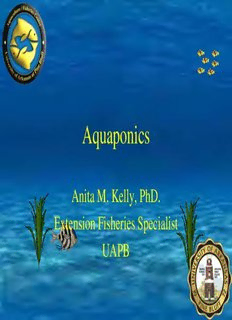
Aquaponics - eXtension PDF
Preview Aquaponics - eXtension
Aquaponics Anita M. Kelly, PhD. Extension Fisheries Specialist UAPB What is Aquaponics? • Melds aquaculture with hydroponics • Modern aquaponics: ~25 years Advantages of Aquaponics • Miserly water use - the water is used very efficiently to grow two crops - fish & plants • Zero environmental impact - no nutrient-rich waste-water discharge, the fish food is used to its maximum potential (to grow fish & plants) • Two crops from the one input - the fish feed entering the system supports the growth of both fish and plants • Small footprint/high density - because of their compact nature, facilities may be located very close to the end users (restaurants, green grocers, food manufacturers, public) in a variety of locations (country, city). • No herbicides or pesticides can be used - healthier Plants filter water that is The Aquaponic Fish returned to produce the fish Cycle wastes Bacteria converts wastes to fertilizer for fish Fish Care 101 • Do not forget the fish • Important Water quality parameters: • Water quality is key • pH • Fish should be: • Alkalinity – Actively swimming – No lesions or red spots • Temp – Eating regularly • Dissolved oxygen • If not – check water quality first! Plant Care 101 • Water, but not too • Important to: much – Test pH every week • Oxygen but moist – Buffer with potassium and calcium buffers to • Nutrients balanced desired pH - nitrogen - phosphorus - calcium What if my fish get sick? • Most diseases are a result of poor water quality • Check water quality • Do water change if necessary • DO NOT ADD SALT! • Quarantine fish if disease is not water quality related What if my plants get sick? • Soil borne diseases will not be a problem • non-chemical methods – biological control • Resistant cultivars • predators • antagonistic organisms • barriers, traps - manipulation of the environment Current Trends • Commercial scale- few but not proven profitable • Mainly home aquaponic systems Dry zone Root zone Solids collection zone
Description: